SPRING 2024


Department of Forestry and Natural Resources




Before we “spring forward” into 2024, I again want to reflect on the participation in last year’s centennial anniversary celebration of Robinson Forest. As we highlighted in the fall edition of inFORm, we had a great turnout from alumni and friends, and on behalf of the college and department, thank you! We look forward to seeing you again at our annual Alumni-Student Fall Picnic on Friday, Sept. 13.
This year will be busy, as our faculty collaborates to generate new ideas and opportunities within our research and Extension enterprises. There is also increased engagement between our faculty and our undergraduates, whether in the classroom as student workers on research and Extension projects or in extracurricular events, including the significant win in this winter’s Kentucky-Tennessee SAF student quiz bowl!
In other news, I will be retiring and stepping down as department chair at the end of January 2025. However, I plan to help with alumni and department development for the next several years. Our dean, Dr. Nancy Cox, has initiated the chair search process. Please stay tuned, as some of you will, no doubt, be asked to engage in the process. This year will be an interesting one, and I have full confidence in the department and great appreciation for your continuing support as we move forward.
-Dr. Jeff Stringer, Department Chair

Announcements White Oak Genetics & Tree Improvement Undergrad Spotlight Graduate Students White Oak Timber Supply and Its Economic Impacts Kentucky Forest Sector Contribution Thomas Poe Cooper Building 730 Rose Street Lexington, KY 40546 (859) 257-7596 forestry.department@uky.edu f orestry.ca.uky.edu @ukyfnr 3 4 10 12 13 14 FOLLOW US ON SOCIAL MEDIA
Photo courtesy of Matt Barton, UK Ag. Communications Front
Ag. Communications
IN THIS ISSUE IN THIS ISSUE Letter From THE CHAIR CONTACT US CONTACT US
cover photo courtesy of Brian Volland, UK
ANNOUNCEMENTS ANNOUNCEMENTS
LOOKING FOR A FORESTRY JOB?
Check out our job board at: forestry.ca.uky.edu/forestry-jobs
LOOKING TO HIRE?
If you would like to post a job opportunity on our job board, email your job announcement to Laura Lhotka (laura.lhotka@uky.edu).

We will post relevant forestry and natural resource job opportunities.

ALUMNI-STUDENT FALL PICNIC
SEPTEMBER 13, 2024
T.P. COOPER BUILDING
SCAN QR CODE FOR MORE DETAILS




MICHAEL AMMERMAN MICHAEL AMMERMAN WELCOME TO THE TEAM
After receiving his bachelor’s degree in forestry from the University of Kentucky in 2020, Michael Ammerman returned to his hometown of Beattyville and taught computer science at Lee County High School while working on an associate degree in applied science in computer information technology. However, he missed Lexington, campus life, and the surrounding areas he had grown to love.
As a new member of the FNR team, Ammerman returns to UK as an Extension associate in the Department of Forestry and Natural Resources. He has also become the assistant director of the Kentucky Master Logger Program and works for the Center for Forest and Wood Certification.
On any given day, Ammerman can be found with timber-harvesting professionals, addressing sustainability and safety issues facing the industry and delivering educational programs to key audiences. He provides group certification for forest owners, loggers, and industry professionals, in addition to certification management and sustainability solutions for firms using wood.
Ammerman loves learning and is working on a master’s degree in digital mapping, something he discovered and became passionate about while taking a cartography class as an undergrad. Yet, he does find time to relax and enjoy being back in Lexington. Of course, he is a UK basketball fan, but you also might find him at Mirror Twin or KS Bar, enjoying trivia night.
3
Promoting White Oak Sustainability
THROUGH PRODUCTION OF IMPROVED, REGIONALLY-ADAPTED SEEDLINGS
DR. L AURA D E W ALD TREE IMPROVEMENT SPECIALIST
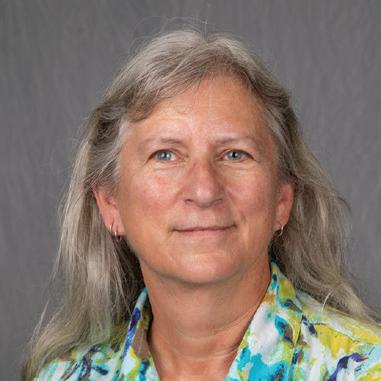
University of Kentucky, in collaboration with a broad range of partners, established the White Oak Genetics & Tree Improvement Program (WOGTIP) to promote sustainability in white oak by taking advantage of the improvement opportunities and helping nurseries obtain acorns that will produce a large number of high quality seedlings.
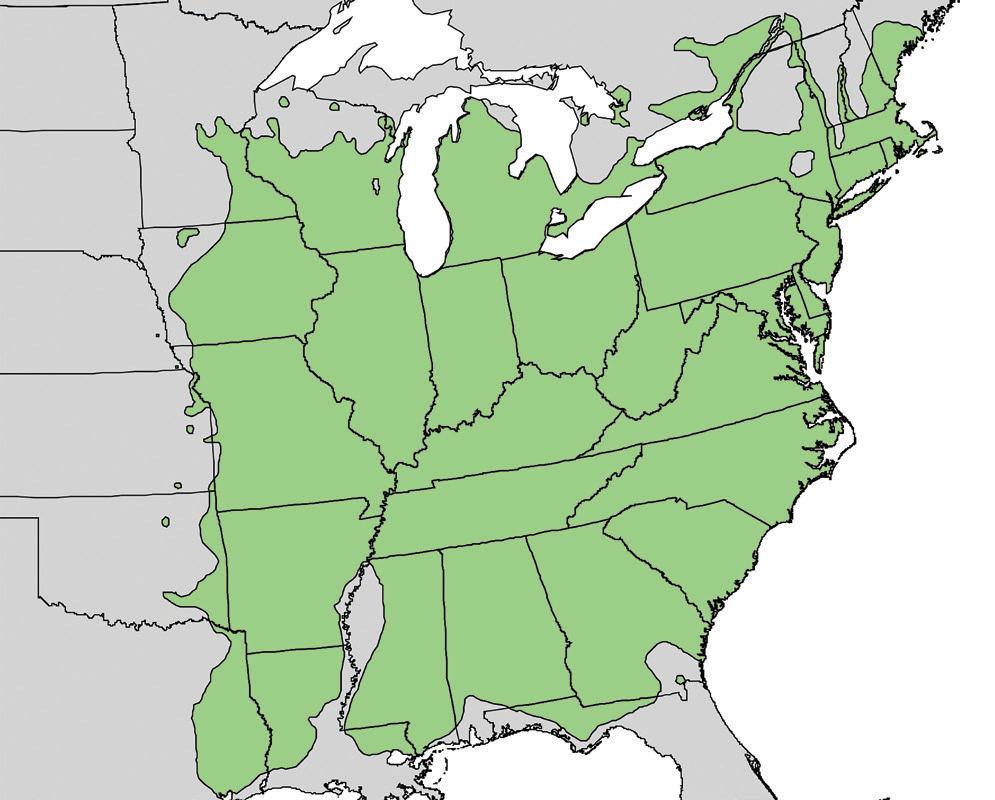

Collect acorns from throughout the geographic range of white oak.
CONTACT INFORMATION:



WHITE-OAK-GENETICS.CA.UKY.EDU
WHITEOAKGENETICS
L AURA. D E W ALD@UKY.EDU
WHY WHITE OAK?
White oak (Quercus alba) is a keystone species in many of the forest ecosystems in the eastern United States. White oak provides critical ecological benefits to the forests in which it occurs, including providing acorn mast to many species of wildlife such as wild turkey and whitetail deer. Mature trees produce high quality hardwood lumber valued by both the timber and cooperage industries. Currently there is an abundant supply of mature trees, but successful regeneration and growth of younger white oak trees needed to replace the older trees is poor. The white oak genetics and tree improvement program was developed to help address this problem.


Evaluate progeny of mother trees in progeny and provenance tests.


Create seed orchards using superior mother trees and their superior offspring.
 White oak range map. Photo courtesy of Atlas of United States Trees
White oak range map. Photo courtesy of Atlas of United States Trees
PHASE 01 PHASE 02 PHASE 03 4
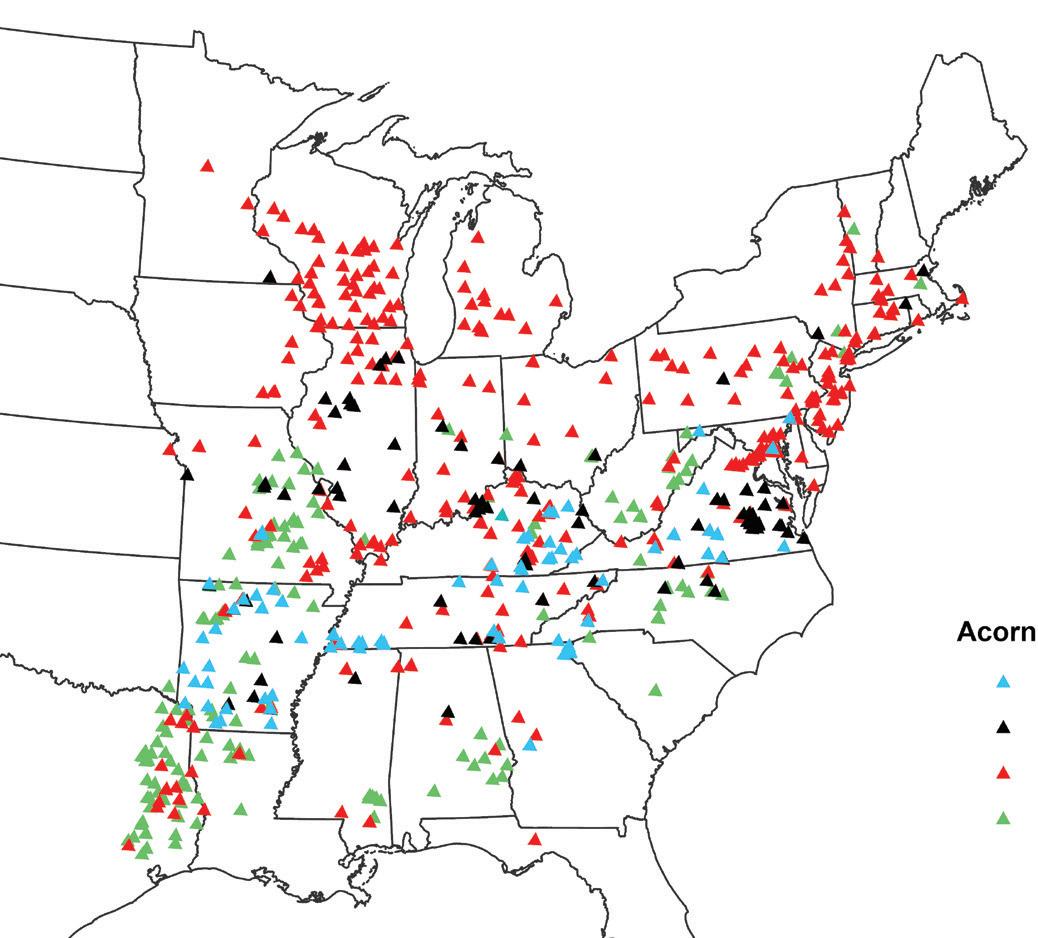

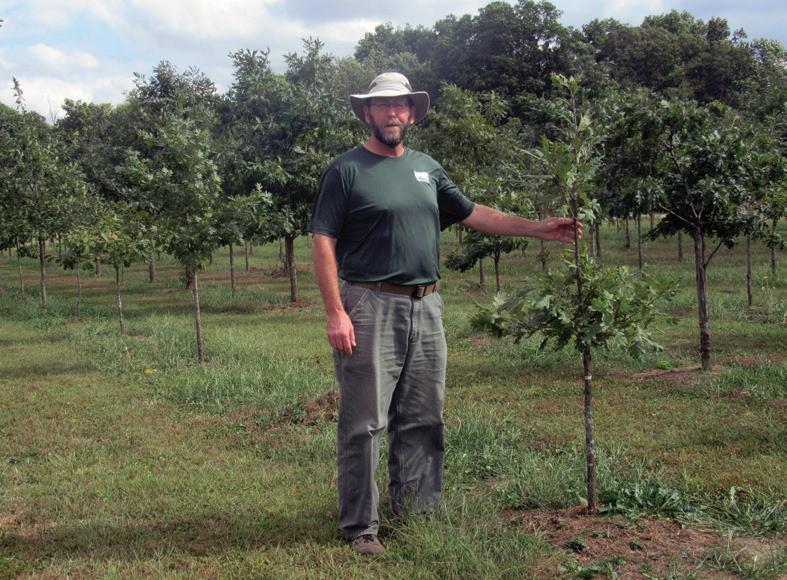

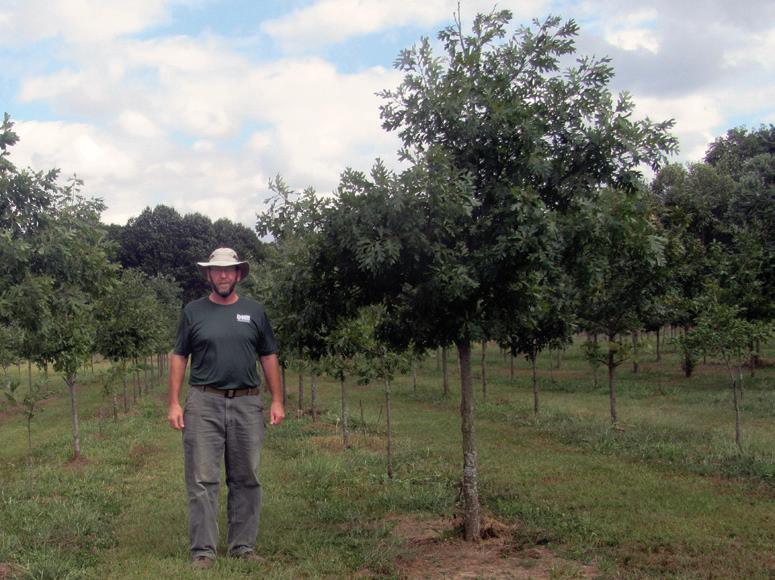


UN-IMPROVED IMPROVED By Numbers 810 ACORN COLLECTIONS 336,430 ACORNS PLANTED 40,000 S EEDLINGS PLANTED into progeny tests 23 PROGENY TESTS 250,000 S EEDLINGS DONATED to research & reforestation Locations of mother trees acorns were collected from. the Provide acorns to nurseries for production of improved seedlings. Acorn Collections 2019 2020 2021 2022 Location of range-wide test Location of regional progeny tests White Oak Progeny Tests Locations of regional and range-wide progeny tests. PROGRAM GOAL For more details. 10-year-old white oak planted on the same site 5
Program Collaborators
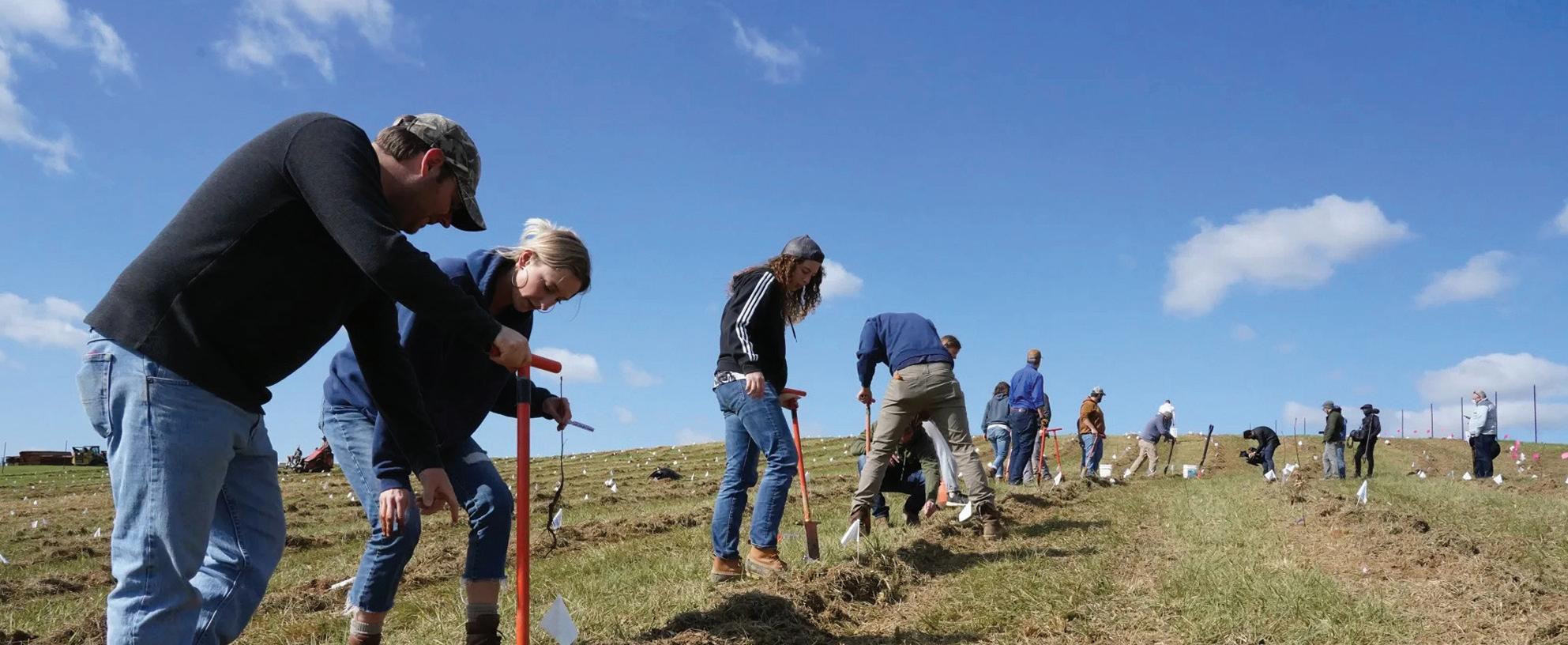
WHAT IS THE TRUE VALUE OF THE WHITE OAK GENETICS AND TREE IMPROVEMENT PROJECT?
While the simple answer is self-evident, once you fully consider the breadth of this project and what can be accomplished through synergistic efforts, you quickly realize the value escalates beyond the obvious.
One of the most important outcomes is that, for the first time, we have gained an understanding of the DNA of the species. WOGTIP allows genomics researchers to sample the genetic diversity of white oaks at one 16-acre field at Maker’s Mark Star Hill Farm in Loreto, Kentucky. This centralized repository of genetic diversity is unprecedented, and numerous studies will emerge that would otherwise never have been attempted. Further, correlating DNA to growth traits will now be achievable, allowing rapid screening for improved traits rather than having to wait for years or decades. The regional progeny tests will allow this work to be operationalized, providing improved seedlings for conservation of the species and enhancing our ability to respond to future insect, disease, and climate-change threats. This strengthens the sustainability of the species, a focus of the White Oak Initiative and an aim that is of critical importance to science, conservation, industry, and our forest-enriched society.
MAKER’S MARK STAR HILL FARM
Iconic Maker’s Mark Distillery sits on more than 1,100 contiguous acres of land that make up Star Hill Farm. In 2021, the University of Kentucky’s Department of Forestry and Natural Resources, under DeWald’s leadership, began a partnership with Maker’s Mark to establish the world’s largest genetic repository of American white oak. The aim was to build a foundation for research and tree improvement to address current and future threats to the trees and to support white oak-dependent industries in rural and urban economies across the region.
Maker’s Mark will perpetually maintain approximately 16 acres of trees, utilizing drip irrigation for optimal care. This endeavor incorporates 530 mother trees sourced from the entire geographic range of white oak. This initiative represents the sole extensive range-wide test of white oak in existence, allowing us to quantify the patterns and range of genetic variation across the full geographic range and adaptive variation critical to changing climates, which sets limits to the movement of mother trees to different areas. Moreover, this project serves to bridge the gap between genomics research conducted in laboratories and practical applications in the field.
“
Maker’s Mark is proud to support the research and sustainability of white oak and is pleased to be a part of ongoing work led by the White Oak Initiative. We have received great support and encouragement from other industry leaders in planting Maker’s Mark’s research forest on Star Hill Farm, and we are working together to improve the quality and vigor of all future seedlings sourced through our state nurseries.
-BRIAN MATTINGLY, DIRECTOR OF STAR HILL FARM OPERATIONS
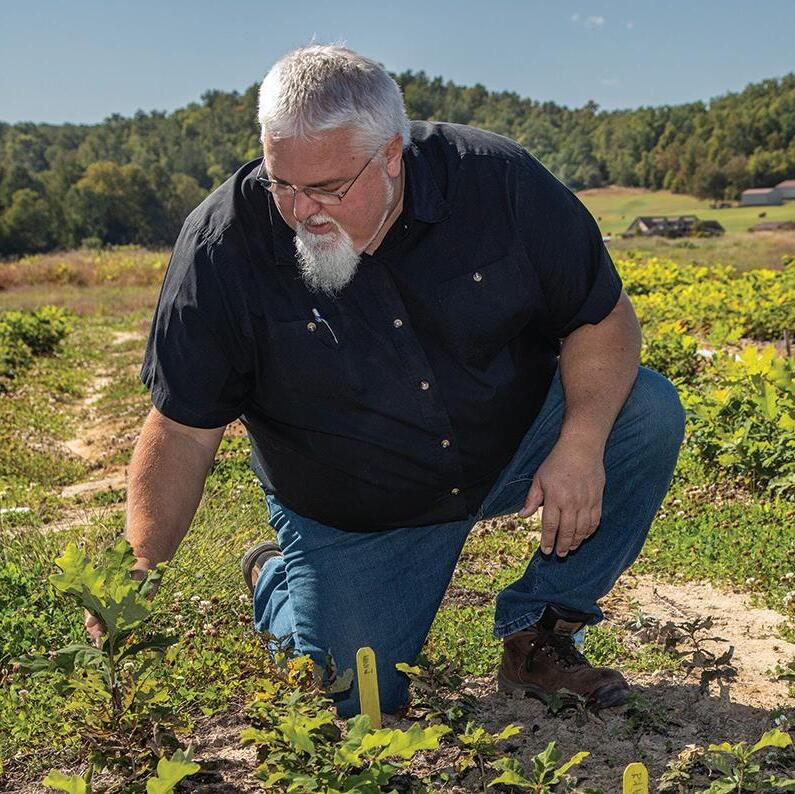 UK Forestry spring camp students planted roughly 1,400 seedlings at Maker‘s Mark in April 2021.
Photo courtesy of Marker‘s Mark
UK Forestry spring camp students planted roughly 1,400 seedlings at Maker‘s Mark in April 2021.
Photo courtesy of Marker‘s Mark
6
MORGAN COUNTY TREE NURSERY KENTUCKY DIVISION OF FORESTRY
The Morgan County Tree Nursery and the University of Kentucky have been involved with the white oak genetics project for five years. The nurseries strive to grow more than 250,000 white oak seedlings to help cover the needs for reforesting Kentucky and providing quality oak seedlings at a low cost to Kentucky citizens. The goal of this project is to isolate genetic properties in white oak and establish seed orchards with genetically superior mother trees. Within 12 to 16 years, these orchards will supply Kentucky’s nurseries with high-quality white oak seedlings from high-quality mother trees, which will increase the quality of white oak for future harvests.
Acorn collectors documented the nearest town and GPS coordinates for each tree they harvested from. These acorns were then hand-planted at the nursery. Other than hand planting, standard nursery practices were used to grow, cold-store, and lift seedlings. In 2023, over 76,000 seedlings went to progeny tests for various research initiatives such as the Adaptive Silviculture for Climate Change project, as well as existing U.S. Forest Service seed orchards and a variety of reforestation endeavors.
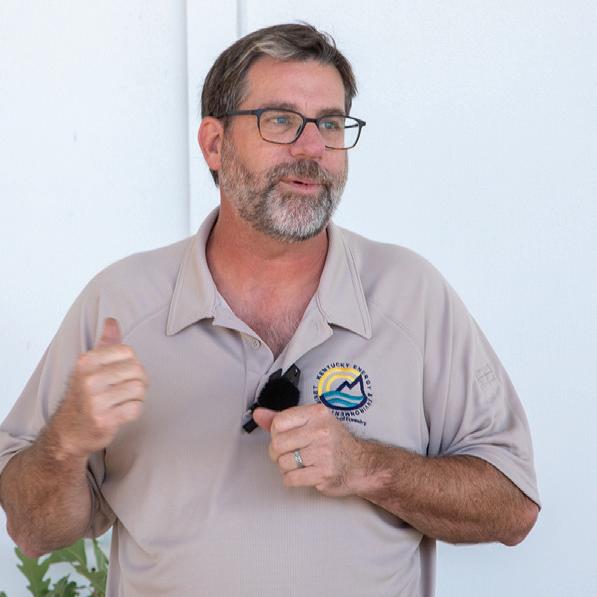
Over the last several years, awareness of white oak has become important after learning that there may be a shortage of quality usable material. White oak has many uses, such as bourbon barrels, hardwood flooring, furniture, and cabinets. The loss of white oak will significantly impact the economics of the timber industry.
-CHARLIE SAUNDERS, KENTUCKY DIVISION OF FORESTRY
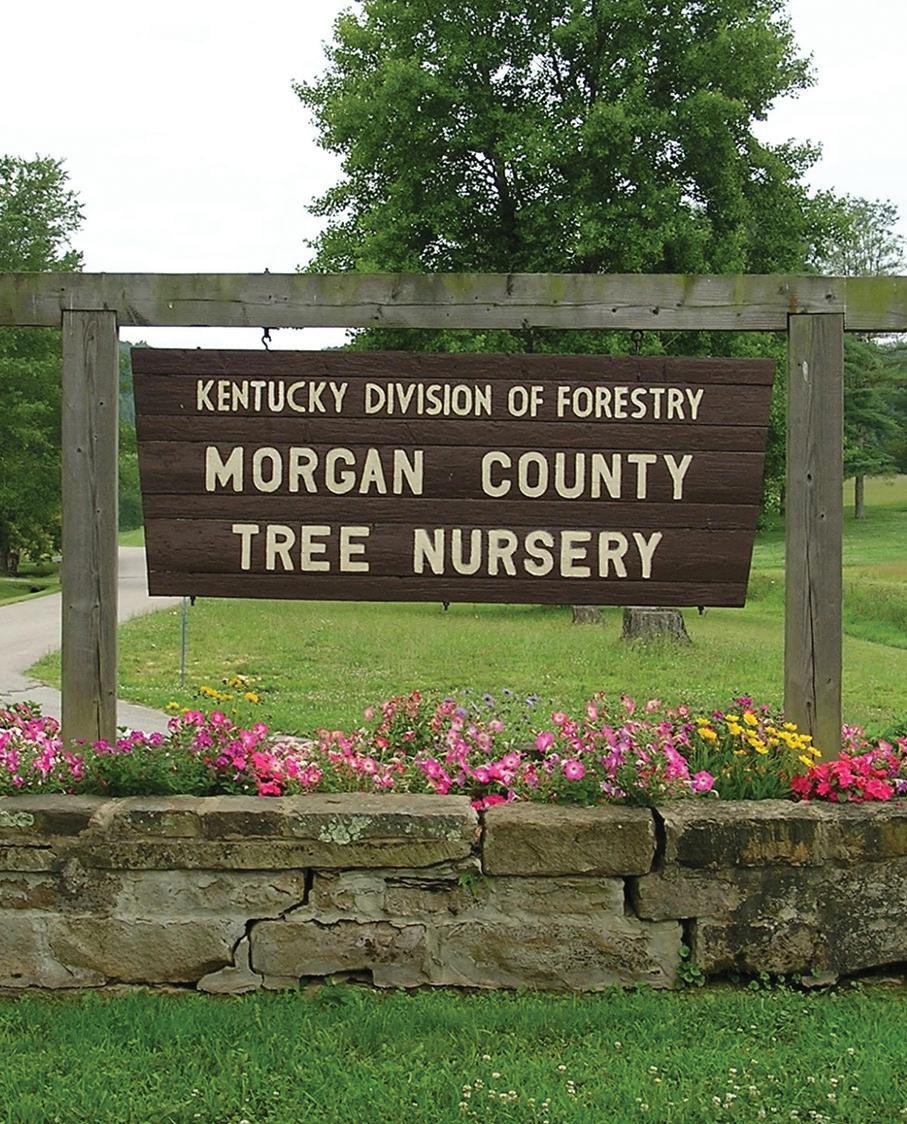





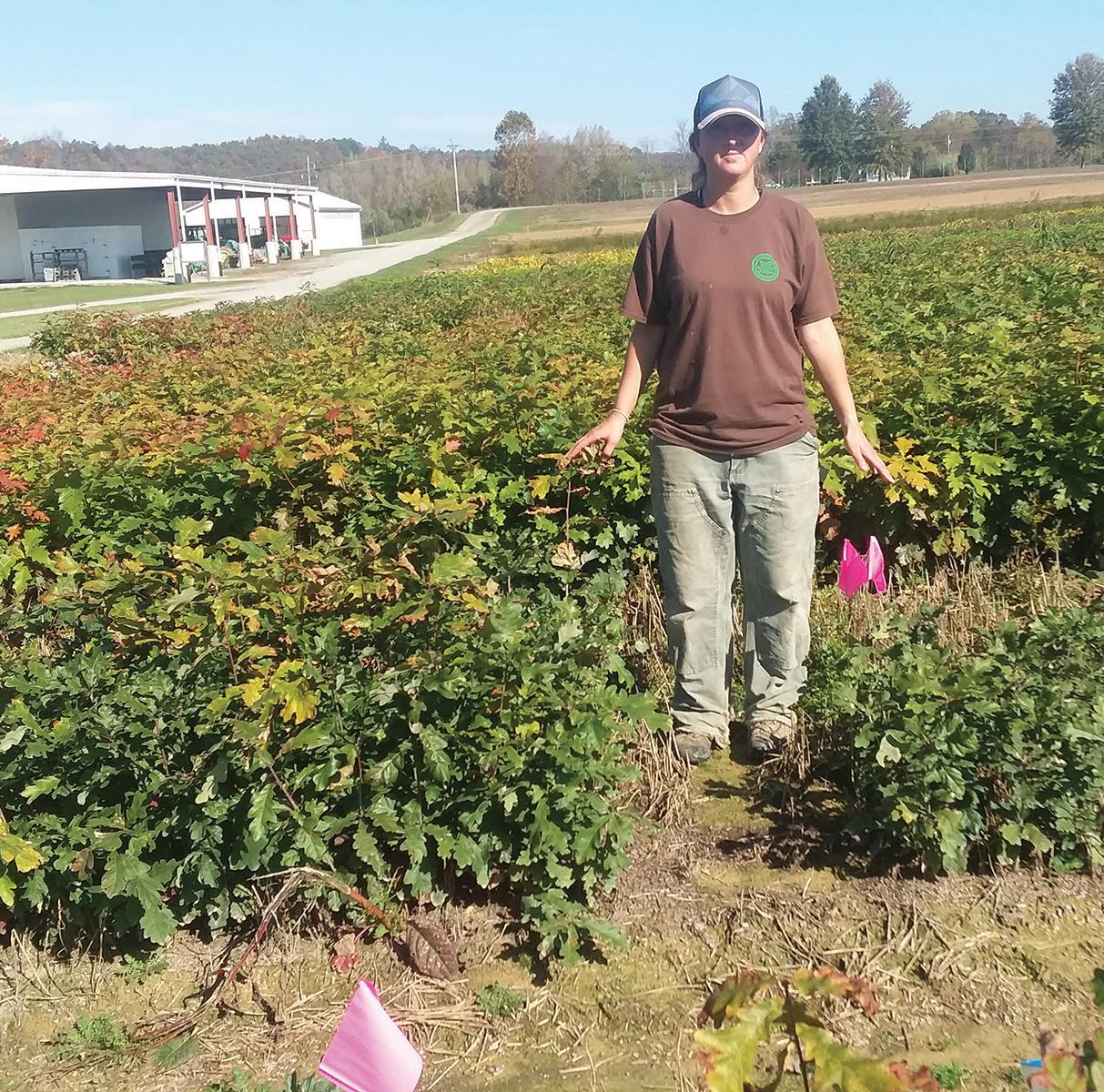 Acorns planted at KDF Morgan County Nursery in 2021. Seedlings in May 2022 from acorns planted in 2021. Seedlings in Fall 2022.
Mother Tree produced superior seedlings on the left compared to seedlings on the right.
Acorns planted at KDF Morgan County Nursery in 2021. Seedlings in May 2022 from acorns planted in 2021. Seedlings in Fall 2022.
Mother Tree produced superior seedlings on the left compared to seedlings on the right.
”
7
Photo courtesy of UK Ag. Communications
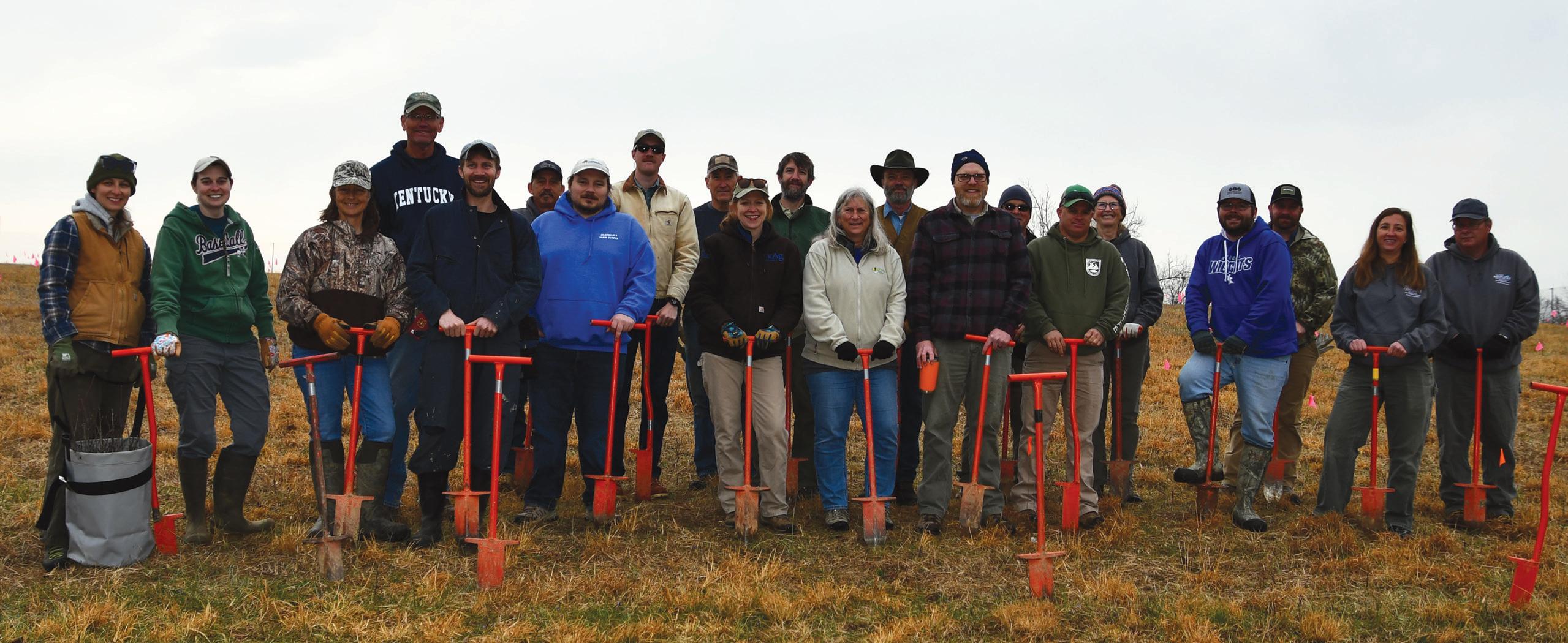
Thanks to all our volunteers! + 75 ORGANIZATIONS
WOGTIP has been successful due to the amazing efforts of many collaborations across the entire geographic range of white oak. These efforts include providing advice, recruiting volunteers, collecting acorns, planting acorns at the nursery and lifting and sorting seedlings for progeny tests, coordinating and installing progeny tests, maintaining progeny tests, and collecting data.
VOLUNTEERS AND COLLABORATIVE PARTNERSHIPS:
• US Forest Service: National Forests, Southern and Northern Research Stations, State, Private and Tribal Forestry, Genetic Resource Management Program
• Bourbon Distilleries
• State Natural Resources Divisions/ Departments
• City and County Governments and Organizations
• Colleges and Universities
• Private NGO Farms
• US Army
• Private and Public Botanical Gardens and Arboretums
• State and County Extension Programs
• Master Gardeners and Master Naturalists
• State Tree Nurseries

• Private Woodland Owners
• Youth Groups such as Boy Scouts, 4-H, FFA, etc.
• State Forestry Associations
• Non-profit organizations such as the Kentucky Distiller’s Association, The Nature Conservancy
• Citizen Scientists and many more...
 Stephen F. Austin State University forestry students who helped collect acorns from Texas. Photo courtesy of Jeremy Stovall Bluegrass Army Depot Planting Volunteers
Stephen F. Austin State University forestry students who helped collect acorns from Texas. Photo courtesy of Jeremy Stovall Bluegrass Army Depot Planting Volunteers
+ 2,000 INDIVIDUALS + 15,000 HOURS DONATED
8
Louisiana Tech University forestry senior class with Drs. Laura Sims, Gordon Holley, Shawn Yang, and Joshua Adams. Acorns were collected as part of an annual field lab in Bottomland Hardwoods class.
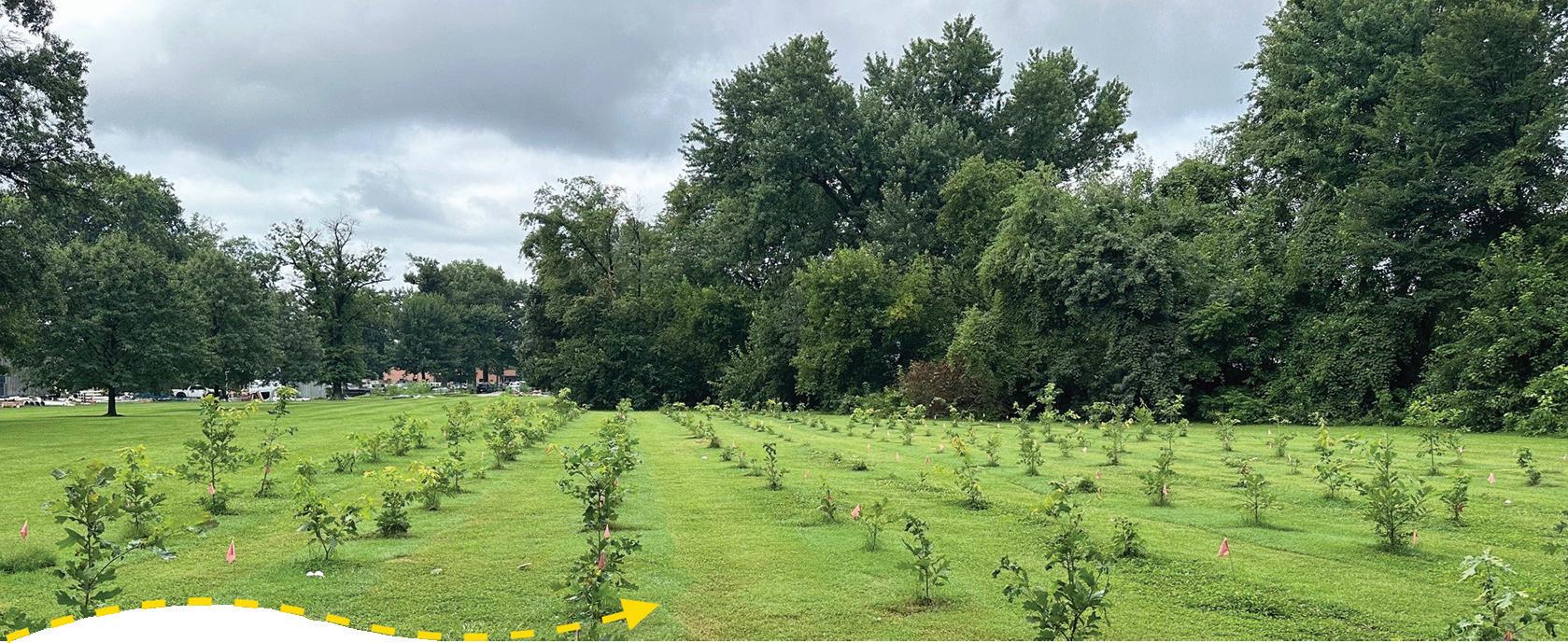
Going Forward
INDEPENDENT SEED ORCHARDS PROGRAM (ISOP)
The demand for acorns producing highquality seedlings will exceed seedling and clonal WOGTIP production. ISOP will supplement WOGTIP’s efforts by creating many small orchards across states that have tree nurseries by using the best 1% of seedlings produced in the nursery. This effort plus WOGTIP will create a steady supply of high-quality white oak acorns for tree seedling nurseries.
“We are piloting this innovative program in Kentucky by supplying 11 private and public landowners with the 1% highest quality white oak seedlings
ADAPTATIONS
Acorns from the tree improvement program will enable state tree nurseries across the geographic range of white oak to produce high-quality seedlings that are also adapted to the growing regions where they will be planted so they are cold hardy enough and will start and stop growing when they should.
Tree nurseries protect local adaptation by not selling seedlings from genetic material that has been moved too far from their geographic origins. These seedlings don’t go dormant when they should and get damaged by cold temperatures, and they suffer frost damage when they flush or grow roots too soon.
from the Kentucky Division of Forestry (KDF) nursery to create white oak seed orchards,” stated Billy Thomas with UK Forestry and Natural Resources Extension and ISOP program coordinator.
Because of the importance of white oak, thanks mainly to the White Oak Initiative, there has been strong interest in participating in the program. Participants make their property available to establish the seed orchards and commit to needed site preparation and maintenance of the seed orchard.
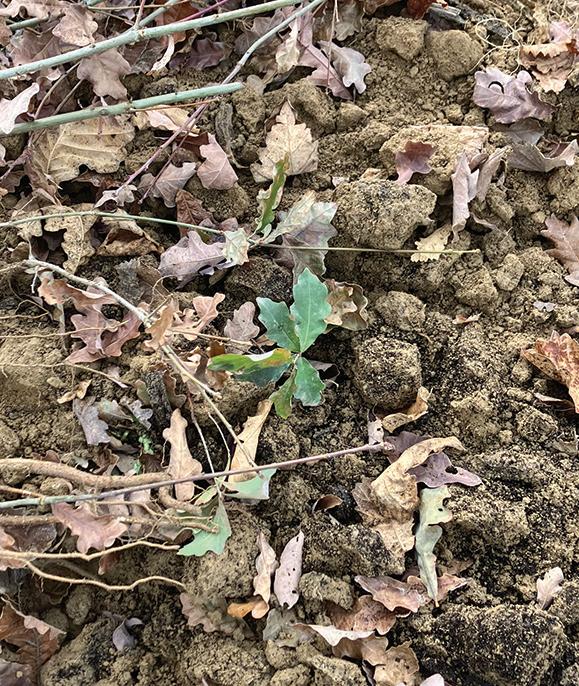
In addition to the involvement of KDF leadership and their tree seedling nurseries, participants are matched with a KDF forester who assists in site scouting and sharing expertise in preparing the site for planting and acorn production. KDF foresters visit each site and sign off on its suitability for ISOP.
“After this pilot program, we plan to expand to more than 100 locations across Kentucky. The seed orchards are 0.5 acres, so within a few years, we hope to have more than 50 acres of seed orchards spread across the state,” Thomas stated.
 Seedlings whose genetic origins are Texas are not adapted to conditions when planted in southern Illinois. They have green leaves in December and stems that are damaged by cold temperatures because they did not go dormant in time. They also have roots growing in February making them vulnerable to spring cold damage and damage during lifting. Photos courtesy of Jeffrey Lewis, Independent Stave Company
Seedlings whose genetic origins are Texas are not adapted to conditions when planted in southern Illinois. They have green leaves in December and stems that are damaged by cold temperatures because they did not go dormant in time. They also have roots growing in February making them vulnerable to spring cold damage and damage during lifting. Photos courtesy of Jeffrey Lewis, Independent Stave Company
9


UK Department of Forestry & Natural Resources
In 2019, I decided to leave my career as a landscape supervisor and return to school. After two years at Kentucky Community and Technical College, I transferred to the University of Kentucky, seeking a bachelor’s degree in forestry. It was the best professional decision I have ever made and has opened doors for me across the profession.
During my time in the forestry program, I found multiple employment opportunities in the department. I served as an assistant to Reneé Williams during the semester, worked during the summer in Forest Health Extension with Dr. Ellen Crocker, and assisted masters and doctoral students with their research. Each of these opportunities led to the next and helped me to form good relationships throughout the department. Additionally, I participated in the UK Fire Cats program for the past two years and worked with the Kentucky Division of Forestry as an emergency wildland firefighter.
Outside the department, I was offered an internship with a local hydrology consulting firm, and following graduation, I will work for them full-time. All these opportunities reflect the deep investment that the Department of Forestry and Natural Resources makes in its students. My observation is that if one is willing to put in the time and effort, the opportunities are vast and varied, and everyone in the department prioritizes student success. As a graduate of the forestry program, I am confident in my skill set and the relationships I have built. For these reasons, I cannot thank the Department of Forestry and Natural Resources enough.
Jason Brown Jason Brown
Jason Brown is recognized as recipient of the 2023 KWOF student scholarship.
Jason Brown working for KDF as an emergency wildfire fighter.
STUDENT SPOTLIGHT 10
FIELD SEMESTER Spring

Old home site in Shearer Hollow on the southern portion of Berea College Forest in Berea, KY
The Spring Field Semester is for students in the junior year of the Forestry program. It is a semesterlong immersion into the practice and application of forestry.
SCAN HERE
T O FOLLOW THE STUDENTS ON THEIR JOURNEY


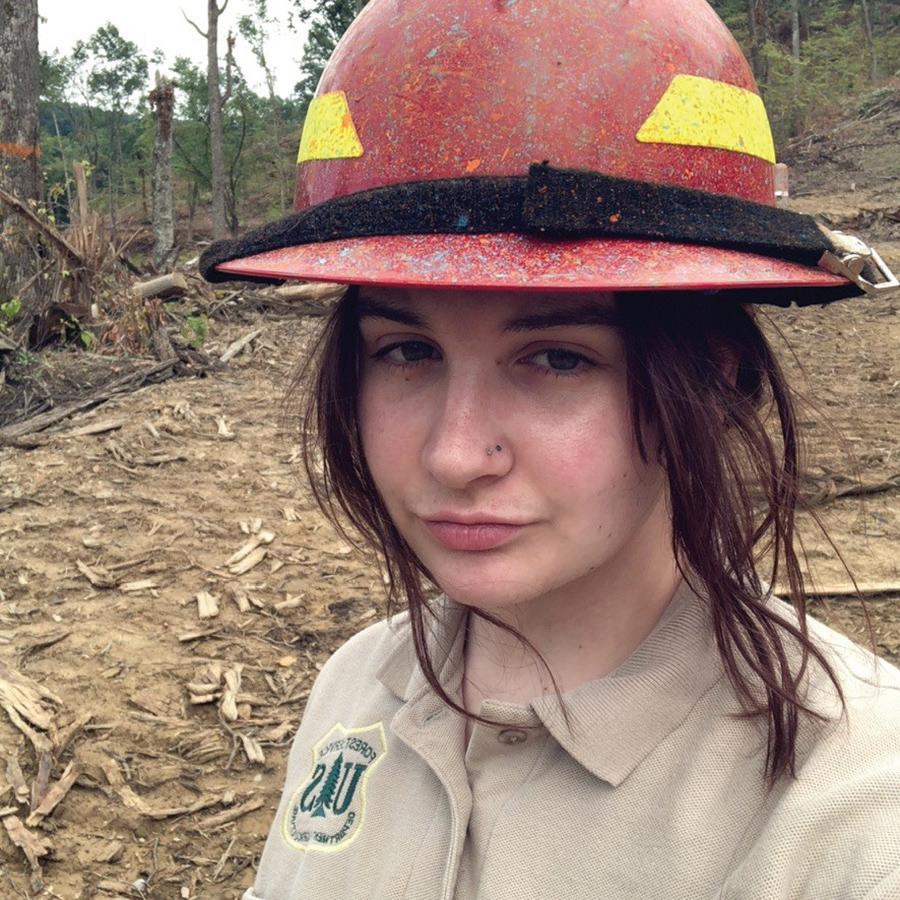
K entucky-Tennessee Chapter of Society of American Foresters
My name is Emme and I’m a forestry major with a minor in wildlife biology and management. I’m currently a dual pathways intern with both the Natural Resources Conservation Service (NRCS) and the Forest Service. I will work for the NRCS in London, Kentucky, this summer as a wildlife forester. I previously worked for UK’s Robinson Center for Appalachian Resource Sustainability and the Wood Utilization Center. I’ve also been involved in the Society of American Foresters (SAF) student chapter and Fire Cats for about two years now.
I’ve grown up around trees, and I have a passion for science and the environment. Originally, I wanted to get into forestry to make guitars (I still do), but forestry has so much more to offer. It’s all so cool! I try to get involved in anything I can do.
I’ve been the Kentucky-Tennessee Society of American Foresters (KTSAF) social media intern for over a year. In 2023, I had great success reaching people over social media, and in 2024, I attended my first KTSAF regional convention. I’ve always been passionate about science education, and I love helping others; KTSAF is perfect for that. I get to make posts about things I learn in classes that I find super interesting, and I can help others learn. My internship supervisor, Katie Fitzsimmons, attended the 2023 SAF National Convention, and we won the SAF social media award.

I find it so awesome to have discovered something that I am intuitively passionate about. Having my passion and my work recognized is really cool, and it inspires me to do more. Forestry is amazing!
Emme Bradley Emme Bradley
11
Graduate Updates Graduate Updates
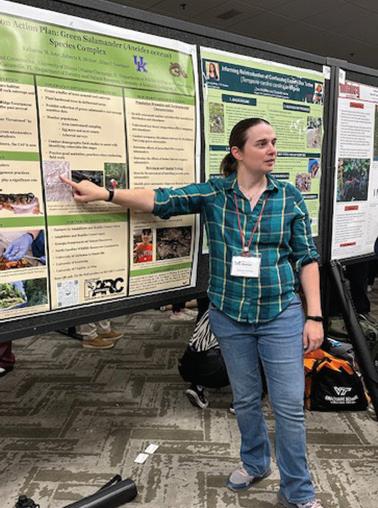


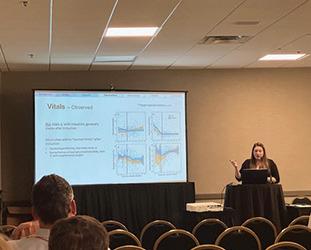
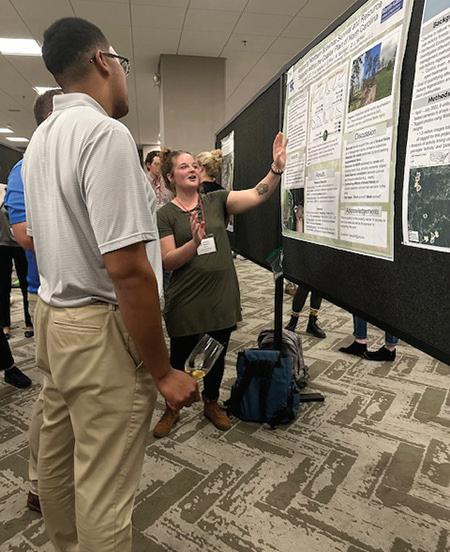

In November, several current and former FNR graduate students, staff, and faculty took part in the Wildlife Society’s 30th annual national conference in Louisville. Doctoral degree candidates Sarah Tomke and Kathryn Greene presented 15-minute oral talks, along with Kate Williams, who recently graduated from the master’s degree program. Master’s degree students Autumn Randall and Lauren Sherman presented research posters. Research analyst Jill Newman also presented a poster on her master’s degree research at Clemson University, and Dr. Steve Price presented a poster on behalf of Rebecca Davenport, who graduated in spring 2023 and now works as a biologist at a wildlife refuge in California. Attendance at this conference would not have been possible without funding provided by the FNR Student Travel Award. This award continues to provide graduate students in this department access to professional development and networking opportunities and is greatly appreciated by the recipients!
 LAUREN SHERMAN
KATHRYN GREENE
JILL NEWMAN
SARAH TOMKE
AUTUMN RANDALL
LAUREN SHERMAN
KATHRYN GREENE
JILL NEWMAN
SARAH TOMKE
AUTUMN RANDALL
12
KATE WILLIAMS
Sustainability of High-Quality White Oak Timber Supply and Its Potential Economic Impacts in Kentucky

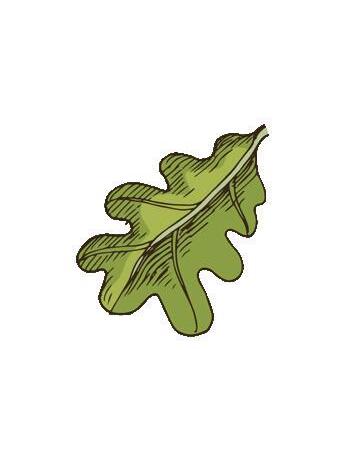
TDR. THOMAS OCHUODHO
ASSOCIATE PROFESSOR OF FOREST ECONOMICS AND POLICY
he production of world-renowned Kentucky bourbon depends on high-quality white oak stave logs, which form the casks that are used in bourbon maturing. The ever-growing bourbon industry has necessitated increasing demand for high-quality (grades 1 and 2) white oak stave logs. However, Kentucky is also witnessing ecological shifts in its historically white oak-dominated forests, mirroring the structural changes in oak forests in the eastern United States—the “oak regeneration problem.” These scenarios present growing concern among stakeholders related to the sustainability of white oak and its associated economic implications.
To address these challenges, we conducted a study with two objectives: (1) to assess historical and projected inventory levels of white oak in Kentucky, and (2) to assess potential economic impacts of projected white oak timber supply, following the overall increased supply of white oak sawlogs but reduced supply of high-quality white oak sawlogs in Kentucky.
Using Forest Inventory and Analysis (FIA) data together with Forest Vegetation Simulator (FVS), we performed a base run analysis of projected inventory levels of white oak sawlogs up to 2068. We further examined projected timber by tree grades to provide an outlook on quality of white oak timber.
Results show that projected white oak sawlogs supply cannot sustainably support current harvest levels beyond 2058. Further, the long-term trends in inventory levels of high-quality white oak sawlogs would be continuously declining, while that of low-quality sawlogs would be steadily increasing. Results generated from a dynamic computable general equilibrium (CGE) model indicate a cumulative present-value GDP reduction of $3.66 billion, a $710 million decline in consumer welfare, and other sectoral contractions over 40 years (2018-2058).
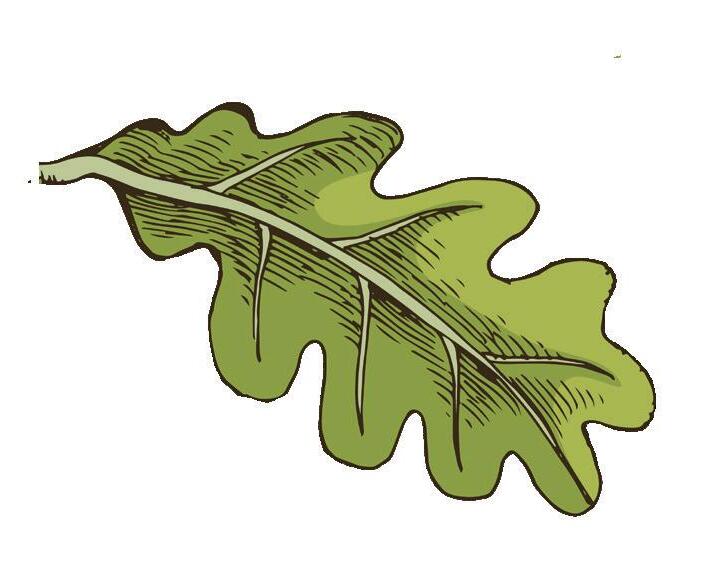
These results call for proactive forest management approaches to stabilize the white oak timber resource supply, in Kentucky and beyond, for the sustainability of the bourbon industry.






INVENTORY (billions
INVENTORY (billions
Projected white oak timber outlook in Kentucky.
bdft)
bdft)
VOLUME (billion cuft) 3.5 3.0 2.5 2.0 1.5 1.0 0.5 0.0
Projected volume of white oak growing stock across diameter class in Kentucky (without harvest).
13

Kentucky Forest Sector

Dr. Thomas Ochuodho works with the FNR Extension team on the annual economic contribution analysis of the Kentucky Forest Sector Economic Contribution Report. This report is presented at the annual Kentucky Farm Bureau Press Conference and shared with members of the Kentucky Forest Industries Association (KFIA), Kentucky Woodland Owners Association (KWOA), members of the Kentucky State Assembly, and the Kentucky congressional delegation in Washington, D.C., among other stakeholders.
Forests cover nearly half the state of Kentucky and are the foundation of a forest sector that is a major economic force in the Commonwealth. This report contains the latest Kentucky forest sector economic contribution estimates, prior estimates, links to data sources and methods, as well as additional information related to the economic importance of Kentucky’s forest resources.

Source: IMPLAN data for Kentucky and the Kentucky forest products industry directory.

SCAN HERE TO READ THE FULL REPORT
14

Economic Contribution
TOTAL ECONOMIC CONTRIBUTION
$18 BILLION
28K people employed by the forest industries
$3.9B
total labor wages
$6.5B
total value added by the forest sector
$1.37B taxes paid at the county, state, and federal level
$20K impact of one harvested acre
$396M Kentucky woodrelated exports

15



SCAN ME FRIDAY SEP. 13 th ALUMNI-STUDENT FALL PICNIC Who will win THIS YEAR’S QUIZ BOWL ? SAVE THE DATE NONPROFIT ORGANIZATION US POSTAGE PAID PERMIT 51 LEXINGTON, KY Department of Forestry and Natural Resources University of Kentucky 105 Thomas Poe Cooper Building Lexington, KY 40546-0073 @ T.P. Cooper (Forestry) Building
























 White oak range map. Photo courtesy of Atlas of United States Trees
White oak range map. Photo courtesy of Atlas of United States Trees








 UK Forestry spring camp students planted roughly 1,400 seedlings at Maker‘s Mark in April 2021.
Photo courtesy of Marker‘s Mark
UK Forestry spring camp students planted roughly 1,400 seedlings at Maker‘s Mark in April 2021.
Photo courtesy of Marker‘s Mark






 Acorns planted at KDF Morgan County Nursery in 2021. Seedlings in May 2022 from acorns planted in 2021. Seedlings in Fall 2022.
Mother Tree produced superior seedlings on the left compared to seedlings on the right.
Acorns planted at KDF Morgan County Nursery in 2021. Seedlings in May 2022 from acorns planted in 2021. Seedlings in Fall 2022.
Mother Tree produced superior seedlings on the left compared to seedlings on the right.


 Stephen F. Austin State University forestry students who helped collect acorns from Texas. Photo courtesy of Jeremy Stovall Bluegrass Army Depot Planting Volunteers
Stephen F. Austin State University forestry students who helped collect acorns from Texas. Photo courtesy of Jeremy Stovall Bluegrass Army Depot Planting Volunteers


 Seedlings whose genetic origins are Texas are not adapted to conditions when planted in southern Illinois. They have green leaves in December and stems that are damaged by cold temperatures because they did not go dormant in time. They also have roots growing in February making them vulnerable to spring cold damage and damage during lifting. Photos courtesy of Jeffrey Lewis, Independent Stave Company
Seedlings whose genetic origins are Texas are not adapted to conditions when planted in southern Illinois. They have green leaves in December and stems that are damaged by cold temperatures because they did not go dormant in time. They also have roots growing in February making them vulnerable to spring cold damage and damage during lifting. Photos courtesy of Jeffrey Lewis, Independent Stave Company













 LAUREN SHERMAN
KATHRYN GREENE
JILL NEWMAN
SARAH TOMKE
AUTUMN RANDALL
LAUREN SHERMAN
KATHRYN GREENE
JILL NEWMAN
SARAH TOMKE
AUTUMN RANDALL

















